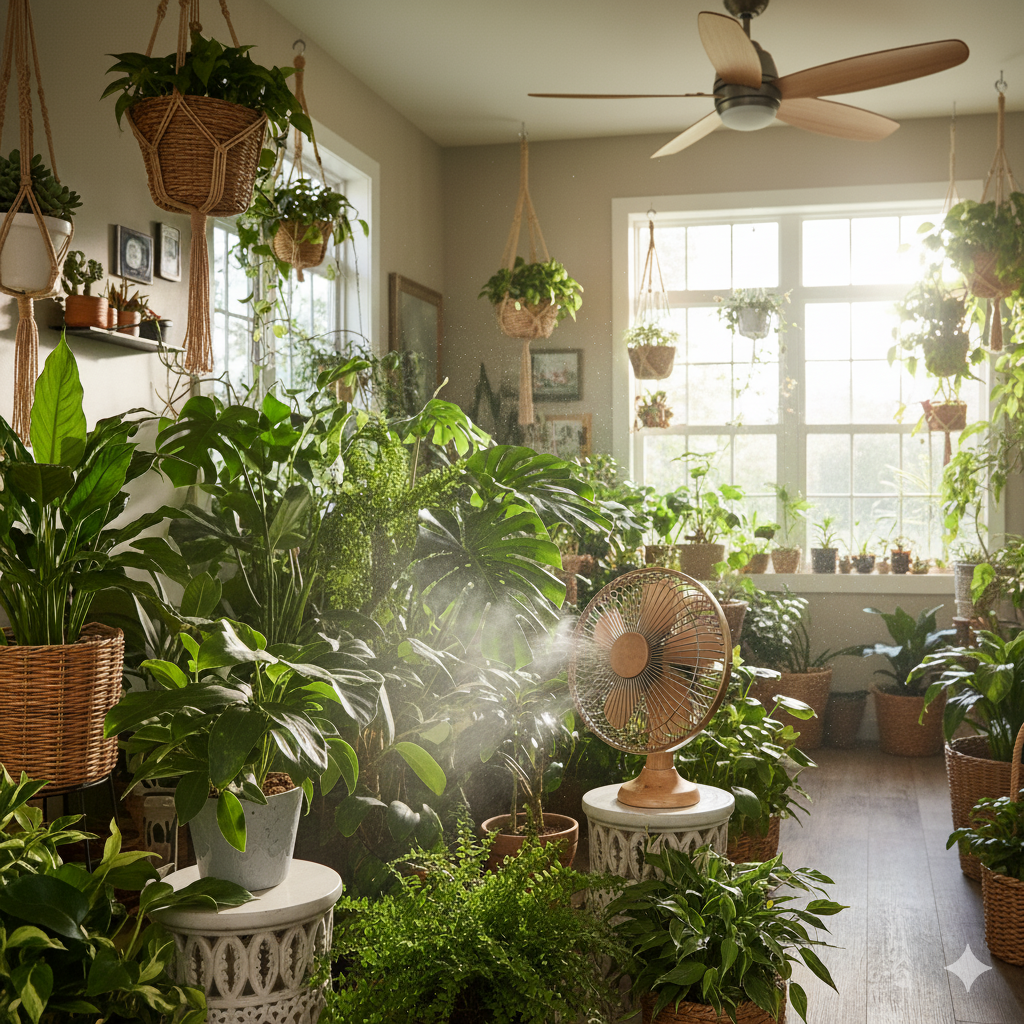Are your indoor plants looking sad and weak?
You give them light and water, but they still struggle.
The problem might be the invisible element you’ve overlooked: still, stagnant air.
Good airflow is vital for your plants.
It provides the fresh carbon dioxide needed for photosynthesis, helps them breathe, and strengthens their stems.
Proper circulation also prevents common issues like mold, pests, and root rot by managing humidity and temperature.
Many growers focus on light and soil but forget about air.
Understanding how air moves and why it’s so important is the secret to helping your indoor garden truly thrive.
Let’s explore how you can create the perfect environment for your plants.
What Is Airflow and Why Is It a Big Deal?
Your home feels comfortable, but is the air healthy for your plants?
Stagnant air can suffocate them slowly, leading to weak growth and sickness.
This invisible problem can ruin your indoor garden.
Airflow is simply the movement of air in a space.
It replaces old, stale air with fresh air, providing plants with the carbon dioxide they need to create food and energy.
This process is as important to them as breathing is to us.
The air in our homes is often very still.
Unlike the outdoors, where wind and breezes are constant, indoor air can become depleted of essential gases that plants need.
When you hear the term “airflow,” it refers to the volume of air being moved, often measured in Cubic Feet per Minute (CFM).
This is different from air velocity, which is how fast the air is moving.
Both are important for creating a healthy environment.
Plants, much like us, need to breathe to convert their food into energy.
This process is called respiration.
They take in gases through tiny pores on their leaves called stomata.
Without moving air, a layer of stagnant air forms around the leaves.
This little bubble of air quickly runs out of carbon dioxide (CO2), the gas plants need for photosynthesis.
At the same time, waste gases from the plant build up, which can slow down growth.
Proper circulation breaks up this stagnant layer, constantly delivering fresh CO2 and carrying away waste.
This simple exchange allows the plant to function efficiently, turning light into the energy it needs to grow strong and healthy.
Key Airflow Terms
- Airflow: The volume of air that is moved from one place to another, measured in units like CFM (cubic feet per minute).
- Air Velocity: The speed at which air moves, measured in units like fpm (feet per minute).
- Air Exchange Rate (AER): The number of times the air inside a room is completely replaced with outside air over a certain period. This is a common term for greenhouses.
- Air Turnover Rate (ATR): The number of times the air inside a room is processed or recirculated by an air conditioning system. This term is often used for indoor facilities.
Understanding these concepts helps you see that just having air in a room isn’t enough.
The air needs to move to be useful to your plants.
How Airflow Helps Plants Grow Strong and Healthy
Do your plants have thin, weak stems that droop easily?
They might be missing their daily workout.
Without the gentle stress of moving air, plants don’t develop the strong structure they need.
Air circulation mimics the natural breezes found outdoors, which encourages plants to grow stronger, more supportive stems.
It also delivers fresh CO2 for photosynthesis and helps regulate temperature and humidity, creating a perfect environment for vigorous growth.
Moving air provides several direct benefits that lead to more robust and resilient plants.
It’s about replicating the natural environment where plants evolved to thrive.
One of the most visible effects is on the plant’s physical strength.
When a plant is exposed to a gentle breeze, it responds by growing thicker cell walls to resist the movement.
This process, similar to how our muscles grow with exercise, results in sturdier stems and branches.
Stronger stems are better able to support the weight of leaves, flowers, and fruits, leading to a healthier plant overall.
Beyond physical strength, airflow is critical for a plant’s basic life-giving processes.
Photosynthesis, the process of converting light into energy, requires a steady supply of carbon dioxide (CO2) from the air.
In a still room, the CO2 right around the leaves gets used up quickly.
Air circulation constantly replenishes this CO2, allowing the plant to photosynthesize efficiently.
At the same time, it whisks away oxygen, which is a waste product of photosynthesis.
Airflow also plays a key role in transpiration, which is how plants release water vapor through their leaves.
This process helps the plant cool down and pulls nutrients up from the roots.
Good circulation carries this water vapor away, preventing the air around the leaves from becoming too humid and allowing transpiration to continue at a healthy rate.
Preventing Common Problems with Good Circulation
Have you found fuzzy mold on your soil or noticed tiny bugs on your plants?
These problems are often caused by still, damp air.
This environment is a perfect breeding ground for diseases and pests.
Good air circulation is one of the best ways to prevent these issues naturally.
It keeps the soil and leaf surfaces dry, which discourages mold, fungus, and root rot.
It also creates an environment that is less welcoming to common houseplant pests.
A lack of air movement creates a microclimate around your plants that can be very harmful.
When air is stagnant, the humidity right around the plant increases every time it releases water vapor through transpiration.
This high-humidity zone is the ideal environment for fungal diseases like powdery mildew and mold to grow.
These fungi thrive in damp, still conditions.
By keeping the air moving, you prevent moisture from settling on leaves and the soil surface for extended periods.
This simple action can dramatically reduce the risk of fungal infections taking hold and spreading to your other plants.
Similarly, many common indoor pests, such as spider mites, aphids, and fungus gnats, are attracted to these same stagnant, humid conditions.
They flourish in environments where they can remain undisturbed.
A gentle, consistent breeze makes it much harder for these small flying insects to land on your plants and lay their eggs.
It also helps dry out the plant’s surfaces, making them a less hospitable place for pests to live and multiply.
Furthermore, airflow above the ground directly impacts the health of the plant below the ground.
When the top layer of soil stays too wet due to poor air circulation, it can lead to a deadly problem called root rot.
Roots need oxygen to function properly, but waterlogged soil has almost no air pockets.
Without air, the roots essentially suffocate and begin to die, which can quickly kill the entire plant.
Simple Ways to Improve Airflow for Your Plants
Ready to help your plants breathe better but not sure where to start?
Creating better airflow doesn’t have to be complicated or expensive.
Small, simple changes can make a huge difference for your plants.
The easiest ways to improve circulation are to open windows, use a small fan, and give your plants enough space.
These methods help mimic a plant’s natural outdoor environment and prevent the problems caused by stagnant air.
You can easily boost the air circulation in your home using several straightforward techniques.
The goal is to create gentle, consistent air movement, not a windstorm.
Use Fans Smartly
A simple fan is one of the most effective tools for an indoor gardener.
- Choose the right type: An oscillating fan is ideal because it moves back and forth, circulating air throughout the room rather than blowing directly on one spot.
- Position it correctly: Place the fan a few feet away from your plants. You want the leaves to tremble slightly, not be blasted with a strong gust of wind, which can dry them out or cause “wind burn”.
- Use a low setting: A fan on its lowest setting is usually enough to create the gentle breeze your plants need. You can run it for just a few minutes each day to get the benefits.
Let in Fresh Air
Natural ventilation is free and effective.
- Open windows and doors: Whenever the weather permits, open up your windows to allow fresh air to come in and stale air to go out. This is one of the easiest ways to improve air quality for both you and your plants.
- Place plants near vents and windows: Positioning plants near a window or a home air vent can also help, but be careful. Avoid placing sensitive plants directly in the path of a cold draft from an air conditioner or a hot blast from a heater.
Give Your Plants Space
Overcrowding is a common mistake that blocks airflow.
- Avoid cramming plants together: When plants are too close, they create pockets of stagnant, humid air, which increases the risk of pests and diseases.
- Follow spacing guidelines: Make sure there is enough room between each plant for air to move freely around the leaves and stems. Using plant stands to elevate some plants can also help improve circulation.
Conclusion
Good airflow is a key, yet often forgotten, part of indoor plant care.
It strengthens plants, prevents disease, and ensures they get the gases needed for healthy growth.
Frequently Asked Questions (FAQ)
Do plants need air circulation at night?
Yes.
At night, plants stop photosynthesizing and instead take in oxygen and release a small amount of carbon dioxide.
Good airflow at night helps with this process and keeps them healthy.
Can a fan be too strong for plants?
Yes.
A fan that is too strong or too close can cause “wind burn,” which dries out the leaves.
It’s best to use an oscillating fan on a low setting for a gentle breeze.
How do you circulate air in a room without a fan?
You can improve circulation by opening windows and doors for natural ventilation.
Also, ensure plants are not overcrowded so air can move freely between them.
Does an air purifier help with airflow?
Yes, an air purifier can help.
In addition to cleaning the air of dust and pollutants, most purifiers have a fan that creates air movement, which benefits nearby plants.
Do hanging plants get better air circulation?
Often, yes.
Hanging plants can improve air circulation because air can move freely all around them, from top to bottom, which is harder to achieve with plants sitting on a surface.
Should the fan blow directly on the plants?
No, it’s better to have the fan pointing near the plants to circulate the air around them.
Direct wind can be too harsh.
An oscillating fan is a great option because it varies the direction of the airflow.







